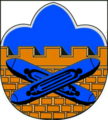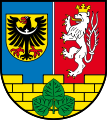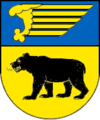Coat of arms of the city of Bautzen

The coat of arms of the city of Bautzen is one of the oldest city coats of arms in Upper Lusatia . The pinnacle wall goes back to the city seal , although its current shape with wall strokes and three pinnacles only developed over time. The crenellated wall, which can be proven to have been used in 1283, was present in the coat of arms of the Budissin region surrounding Bautzen at the latest since 1363 . Due to Bautzen's suburb of the Upper Lusatian Six-City Association , coats of arms and seals outside of the federal government were seen over time as the emblem of the six cities and later as the emblem of the entire state of the six cities. With the inclusion of the coat of arms in the seal of the Saxon Elector Johann Georg I , the Bautzen city coat of arms was recognized as the coat of arms of the Margraviate of Upper Lusatia , although only the coats of arms were the same and the full coats of arms differed.
As the coat of arms of Upper Lusatia , the battlements and the Bautzen city colors blue and yellow form the basis of many coats of arms in Upper Lusatia, for example the coat of arms of the Niesky city and the coat of arms of the Görlitz district . With reference to historical circumstances, the coat of arms is also the coat of arms of the Bautzen district , although the district does not have a full coat of arms.
Blazon
The official description of the coat of arms reads: "In blue, a golden wall with three battlements and strokes of the wall." Crest: "On a gold-crowned, inclined, silver spangenhelm with a blue-gold helmet cover, a closed blue flight , covered with a three-pinned golden wall."
history
The image of the three-tinned wall appears in the oldest known Bautzen city seal from 1283. The seal from the time of the rule of the Brandenburg Ascanians (1254-1319) shows a high, completely open gate with three battlements and two towers on both sides, each of which is also provided with three battlements and painted walls. The crenellated wall was first documented as the city's coat of arms in 1484, but it is believed that it was used as such over a century earlier.

The use of the coat of arms for the entire state of Budissin has been documented since 1363, when Emperor Charles IV included it in the seal of his son and designated successor, the two-year-old Bohemian King Wenceslaus IV, alongside the coats of arms of other crown lands. It is noticeable that the coat of arms of Oberlausitz on this seal contains two bare battlements without a wall. In another seal of Wenceslas from 1373, the coat of arms of Upper Lusatia is shown with a real wall without line marks, "on which two whole battlements rise in the middle and half a pinnacle on both sides, close to the edge of the shield."
In an Augsburg chronicle, according to the Augsburg delegates, it is reported from the funeral of Charles IV in 1378 that a flag with the battlements in the blue field from the Budissin region was seen among the representatives.
Bautzen had assumed a dominant position within the Upper Lusatian six-city federation , although Görlitz was the capital of the state of Görlitz and for a time also the larger city. The Görlitz Council therefore repeatedly resisted the establishment of the Bautzen coat of arms as the coat of arms for the federal government. The weakening of the six cities by the Pönfall in 1547 ensured that the Görlitz resistance disappeared and the coat of arms was able to establish itself for the entire Upper Lusatia in the following period.
Through his assistance in the election of the Bohemian king against Emperor Ferdinand II. , Elector Johann Georg von Sachsen received the margravate of Upper and Lower Lusatia as a pledge in 1623. As a result of the Peace of Prague , the two margravates were transferred from the Kingdom of Bohemia to the Electorate of Saxony . As Elector of Saxony and Margrave of Upper and Lower Lusatia, Johann Georg included the two coats of arms with the Lower Lusatian ox and the golden battlement wall on a blue field in his seal, whereby the Bautzen city coat of arms was officially recognized as the coat of arms of Upper Lusatia.
During the administrative reform of 1952 , from which the Bautzen district emerged in a new shape, the previous district coats of arms were abolished. After German reunification, the district had taken over the old city coat of arms again as the district coat of arms, but presented it in a slightly different shield shape with a curved upper boundary line to distinguish it from the city coat of arms. The approval by the Dresden Regional Council took place on January 14, 1992. The from the The district of Bautzen , which emerged from the Saxon district reform on August 1, 1994, took over the coat of arms, as did the once again enlarged district of Bautzen, which emerged from the district reform on August 1, 2008 .
Derived representation in other coats of arms
The communities of Cunewalde and Großschönau as well as the city of Niesky have coats of arms, which represent a golden battlement wall on a blue shield. In the Cunewald coat of arms, the church tower replaces the central battlement. The Niesky coat of arms is complemented by a cross and a hammer. The Großschöna coat of arms has five battlements, the stylized local mountain Lausche in the background, as well as two crossed web shooters .
Several districts in Upper Lusatia used the coat of arms of Upper Lusatia and thus also the coat of arms of Bautzen. These include the Prussian districts of Hoyerswerda (1935) and Rothenburg (1937), the post-reunification districts of Weißwasser (1990) and Hoyerswerda (1990/1995), the Lower Silesian Upper Lusatia District (1995) and its successor, the Görlitz district (2009).
Many other community and district coats of arms take up or took up the colors blue and yellow or gold in order to underline that they belong to Upper Lusatia. Examples of this are the coats of arms of the cities of Bernsdorf , Lauta , Reichenbach / OL and Weißwasser / OL , the coats of arms of the communities Boxberg / OL , Burkau , Göda and Krauschwitz , and the coats of arms of the districts of Niesky , Kamenz and Löbau-Zittau .
Sources and further reading
literature
- Eckhart Leisering: Coat of arms of the independent cities and districts in the Free State of Saxony . mdv, Mitteldeutscher Verlag, Halle / Saale 2000, ISBN 3-89812-069-4 .
- Hermann Knothe : The state coat of arms of Upper Lusatia. In: New archive for Saxon history and antiquity . Third volume, second issue, Dresden 1882, pages 97–117. ( Full text on Wikisource )
- ↑ page 113
- ↑ Page 99 ( seal image on Wikimedia Commons )
- ↑ page 101
Footnotes
- ↑ Seal impression and seal description after Otto Posse : The seals of the German emperors and kings . Volume 5, Dresden 1913, pages 42 and 43 ( digitized on Wikisource ).
References
The list of coats of arms in the Bautzen district and the list of coats of arms in the Görlitz district provide an overview of the municipal coats of arms in the German part of Upper Lusatia, many of which relate to the coat of arms of Upper Lusatia .






















